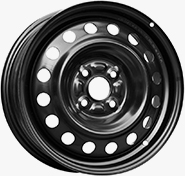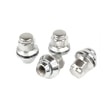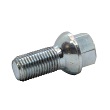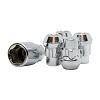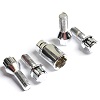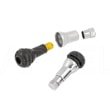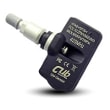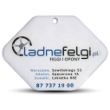Ventilated brake discs – advantages and types
Ventilated brake discs are technologically advanced components widely used in modern cars. Thanks to their design, ventilated discs effectively dissipate heat generated during braking, preventing brake overheating and loss of performance. In this article, we'll discuss which brake discs to choose, how ventilated discs work, and what benefits they bring to everyday vehicle use.
Contents
- How do ventilated brake discs work? Learn how they work.
- What is the difference between solid and ventilated brake discs?
- What types of ventilated discs are there and which option is better for your car?
- The impact of ventilated brake discs on the appearance of rims – aesthetics and functionality
- The most important advantages of ventilated brake discs
- How to choose pads for ventilated brake discs?
How do ventilated brake discs work? Learn how they work.
Ventilated discs are advanced braking components that differ from traditional solid discs due to their special design. These discs feature internal ventilation channels that allow air to flow between the two layers of the disc , which cools the disc during braking, preventing it from overheating. This solution is particularly effective during heavy braking, when the heat generated can affect the efficiency of the entire braking system.
Ventilated brakes operate by dissipating heat, minimizing the risk of disc deformation and extending its lifespan. High temperatures can lead to brake fade, a decrease in braking efficiency, and ventilated discs reduce this risk. Therefore, they are often chosen for sports cars and heavily used vehicles, where maintaining consistent braking performance even after extended use is crucial.
Additionally, ventilated discs minimize wear on other system components, such as brake pads . Thanks to improved heat distribution, these discs reduce the risk of overheating and pad cracking. Compared to solid discs, ventilated models offer a longer service life for the entire braking system, contributing to safety and driving comfort. If you're unsure which brake discs to choose, consider that ventilated models also have a positive impact on aluminum rims , subtly enhancing their appearance.
What is the difference between solid and ventilated brake discs?
Many drivers upgrading their vehicles face the question: should they choose ventilated or solid brake discs? The two variants differ primarily in their construction. Solid discs are homogeneous disks that lack special ventilation channels. They are simpler and cheaper to manufacture, but their heat dissipation capacity is limited, which can lead to overheating during heavy braking. For this reason, solid discs are more commonly used in city vehicles, which don't require such intensive braking.
Ventilated discs, on the other hand, feature internal channels that allow air to flow between the two layers of the disc. This significantly improves their heat dissipation and makes them more resistant to overheating during intensive use. Ventilated discs are particularly popular in sports cars and heavier vehicles, where the braking system is subjected to greater loads and thermal demands.
So, which brake discs should you choose? The choice between these two types depends on your vehicle and driving style. Ventilated discs are better for situations where braking is more aggressive and frequent, as they provide better heat dissipation and greater durability. They also improve the wheel's appearance, so you can match them with black rims or other attractive rim designs. Solid discs, on the other hand, may be sufficient for more relaxed city driving – where intense brake heat isn't a common problem.
| Characteristic | Solid brake discs | Ventilated brake discs |
|---|---|---|
| Construction | Homogeneous discs without ventilation channels | They have internal ventilation channels |
| Ability to dissipate heat | Limited, may overheat | Very good, effectively dissipates heat |
| Application | City vehicles, quiet ride | Sports cars, heavily used vehicles |
| Durability of the braking system | Shorter lifespan due to overheating | Longer life, better cooling |
| Cost | Lower | Higher |
| Fading resistance | Low, susceptible to performance drops | High, fade-resistant |
| Impact on rims | No aesthetic impact | They emphasize the dynamic appearance and improve the aesthetics of the rims. |
What types of ventilated discs are there and which option is better for your car?
There are two basic types of brake discs, which differ in construction, among other things. But which should you choose: drilled or slotted discs? Choosing the right type depends on your driving style, vehicle type, and brake performance expectations.
Slotted brake discs – applications and advantages
Slotted discs feature grooves on their surface that help remove gases and brake dust , improving braking efficiency. Additionally, the slots help improve friction between the disc and brake pad, shortening stopping distances. Slotted discs are often chosen by sporty drivers who prioritize braking performance in demanding conditions.
Drilled brake discs – applications and advantages
Drilled discs feature holes that increase heat dissipation and improve brake cooling. An additional advantage is the disc's reduced weight, which reduces the vehicle's rotating mass and improves dynamics. Drilled discs are an excellent choice for vehicles used in intense conditions.
The impact of ventilated brake discs on the appearance of rims – aesthetics and functionality
Ventilated brake discs significantly impact a vehicle's aesthetic, especially in the context of modern aluminum rims. Their advanced design, visible through the rim openings, adds a sporty and technical touch to the car. Ventilated brake discs, with their openings and ventilation channels, emphasize the vehicle's dynamic appearance, particularly appealing to owners of cars with 18-inch rims and larger.
Aesthetics aren't the only consideration. The functionality of ventilated discs is equally important – they provide improved cooling, protecting the brakes from overheating. This type of design is particularly well-suited to 19-inch rims , which allow for better airflow around the discs, making the braking system more efficient.
Larger rims, such as 20-inch aluminum rims , combined with ventilated discs improve the vehicle's overall aerodynamics and brake system cooling efficiency, thus extending the life of the discs and pads. This combination of aesthetics and functionality is the perfect choice for those seeking not only great looks but also improved braking performance.

The most important advantages of ventilated brake discs
Ventilated brake discs offer numerous benefits that translate into improved braking performance and safety. One of the main advantages is efficient heat dissipation. Furthermore, ventilated brake discs ensure longer service life for both the discs and the brake pads, resulting in lower operating costs and improved vehicle reliability.
Increased braking performance thanks to improved heat dissipation
Ventilated brake discs efficiently dissipate heat, preventing the braking system from overheating. This allows the discs to maintain braking effectiveness even under heavy use – crucial for road safety.
Extended life of brake discs and pads
Improved cooling also extends the life of both the discs and brake pads . Reduced heat buildup in the discs makes the material less susceptible to deformation and wear.
Fade Resistance – Maintain brake performance under heavy use
Ventilated discs are more resistant to brake fade, a phenomenon that reduces braking performance at high temperatures. This is especially important when driving in the mountains or on highways, where heavy braking can quickly overheat traditional discs.
Improved road safety – predictability of vehicle behavior when braking in all conditions
Ventilated discs ensure predictable braking , which is extremely important. It's important to remember that, especially in challenging conditions like rain, snow, or intense driving, effective braking can save lives.
How to choose pads for ventilated brake discs?
Selecting the right brake pads for ventilated discs is crucial to maintaining the high performance and safety of the braking system. Pads must be matched to the disc type, as not all pad materials work well with advanced ventilated discs. It's important to choose pads with high heat resistance – this will ensure effective braking and minimize the risk of system overheating.
For drilled or slotted discs, it's worth considering brake pads, which offer increased durability and better adhesion to the disc. The pad material should be compatible with the more aggressive disc surface to prevent premature wear. Selecting the right components can significantly impact the lifespan of the entire braking system, while also improving driving comfort and safety.
Ventilated brake discs offer significant benefits, such as extended service life and fade resistance. Furthermore, thanks to effective cooling, they enhance safety and provide better performance. However, when choosing between drilled and slotted discs, it's important to consider your driving style and the vehicle's technical requirements.
Recommended

4x rims 20 5x114,3 for JEEP Cherokee KK KJ FORD EXPLORER Escape KIA Sportage - HX035 (B5902)


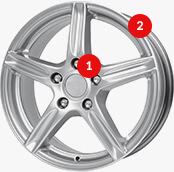

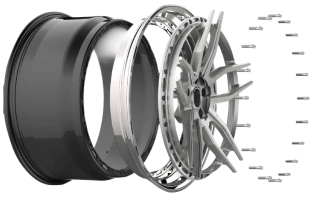
 Modern design
Modern design Perfect fit
Perfect fit High durability
High durability Free shipping within 24 hours
Free shipping within 24 hours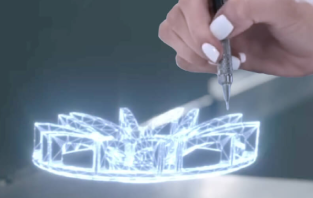
 Individual project
Individual project Dedicated caregiver
Dedicated caregiver